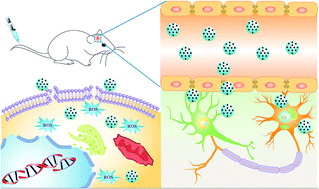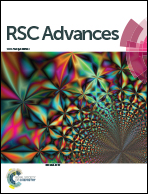Implications for blood-brain-barrier permeability, in vitro oxidative stress and neurotoxicity potential induced by mesoporous silica nanoparticles: effects of surface modification†
Abstract
The increase in the abundance and practical applications of nanomaterials has led to growing concern over the potential adverse effects of nanoparticles on human health. Their unique structure makes mesoporous silica nanoparticles (MSNs) an ideal platform for developing multifunctional nanocarriers, including non-viral gene delivery in the central nervous system (CNS). However, the potential neurotoxicity of the MSNs remains largely unclear. In this study, we explored the biological effect of MCM-41 type MSNs on blood-brain-barrier (BBB) permeability, neuronal damage, and the mediation of neurotoxicity with surface chemistry. With or without the ligand transferrin (Tf), which could interact with the transferrin receptor expressed at the BBB, in vivo imaging indicated that both MSN–Cy–Tf and MSN–Cy may enter into the brain, suggesting their potential to deliver therapeutic agents across the BBB. However, a risk arises that is associated with this permeability. A histological observation of the hippocampus confirms the CNS delivery of MSNs and indicates neuronal damage, characterized by neuronal cell loss, nuclei shrinkage, and the disintegration of neurons, suggestive of in vivo neurotoxicity. With the PC12 cell, a model for the dopaminergic neuron, an in vitro examination suggests that various surface modified MSNs decrease the cell viability and cause oxidative stress with an elevation of reactive oxygen species (ROS), a depletion of glutathione (GSH), leakage of lactate dehydrogenase (LDH), and the generation of malondialdehyde (MDA) in a concentration-dependent manner. Compared with the pristine MSNs which induce the severest injury impact on the cells, thiol modified MSN–SH nanoparticles show significantly lower injury effects among the test MSNs, suggesting the possibility to mediate the neurotoxicity by modifying the surface chemistry of this kind of the nanomaterial for biomedical applications.


 Please wait while we load your content...
Please wait while we load your content...